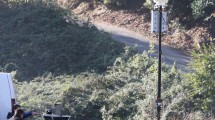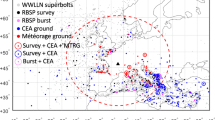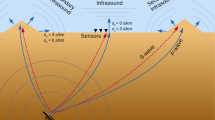Abstract
NUMEROUS experiments have been conducted during the past four decades to determine the characteristics of round-the-world short-wave radio signals and their relationship to world-wide ionospheric conditions. Such echoes have been received over transmitter-receiver paths of up to 10,000 kilometres in length, the radio pulses presumably passing on about the world to arrive at the receiving site approximately 138 milliseconds (ms) later than the direct signal. Closely linked to the round-the-world investigations is the question of antipodal effects; that is, the geometric focusing of short-wave radio signals by the ionosphere at a point diametrically opposite to a transmitter on the Earth's surface. First postulated by Marconi1, antipodal transmissions have been investigated at certain discrete frequencies by several investigators2–4. However, to our knowledge, synchronized step frequency soundings previously have not been conducted between antipodal transmitter and receiver sites.
This is a preview of subscription content, access via your institution
Access options
Subscribe to this journal
Receive 51 print issues and online access
$199.00 per year
only $3.90 per issue
Buy this article
- Purchase on Springer Link
- Instant access to full article PDF
Prices may be subject to local taxes which are calculated during checkout
Similar content being viewed by others
References
Marconi, S. G., Proc. Inst. Rad. Eng., 10, 215 (1922).
Eckersley, T. L., J. Inst. Elec. Eng., 65, 600 (1927).
Berkner, L. V., J. Res. Nat. Bur. Stand. (1931).
Gerson, N., et al., J.G.R., 67, 10, 4084 (1962).
Quaeck, E., Proc. Inst. Rad. Eng., 15, 341 (1927).
Quaeck, E., Proc. Inst. Rad. Eng., 15, 1065 (1927).
Quaeck, E., and Moegel, H., Proc. Inst. Rad. Eng., 17, 791 (1929).
Taylor, A. H., and Young, L. C., Proc. Inst. Rad. Eng., 16, 561 (1928).
Hess, H. A., Proc. Inst. Rad. Eng., 40, 1065 (1952).
Luscombe, G. W., Nature, 180, 138 (1957).
Isted, G. A., Marconi Rev., 21, 173 (1958).
Ortner, J., J.G.R., 64, 2464 (1959).
Stein, S., J.G.R., 63, 217 (1958).
Fenwick, R. B., Tech. Rep. 1004–1, Radio Sci. Lab., Stanford Univ. (Jan. 1962).
Fenwick, R. B., and Villard, O. G., Tech. Rep. 1004–2, Radio Sci. Lab., Stanford Univ. (March 1962).
Von Schmidt, O., Z. Tech. Phys., 17, 433 (1936).
Author information
Authors and Affiliations
Rights and permissions
About this article
Cite this article
BANKS, P., BUSCH, H. A Step-Frequency Pulse Experiment with High-frequency Antipodal and Circulating Signals. Nature 198, 570–571 (1963). https://doi.org/10.1038/198570a0
Issue Date:
DOI: https://doi.org/10.1038/198570a0
Comments
By submitting a comment you agree to abide by our Terms and Community Guidelines. If you find something abusive or that does not comply with our terms or guidelines please flag it as inappropriate.



